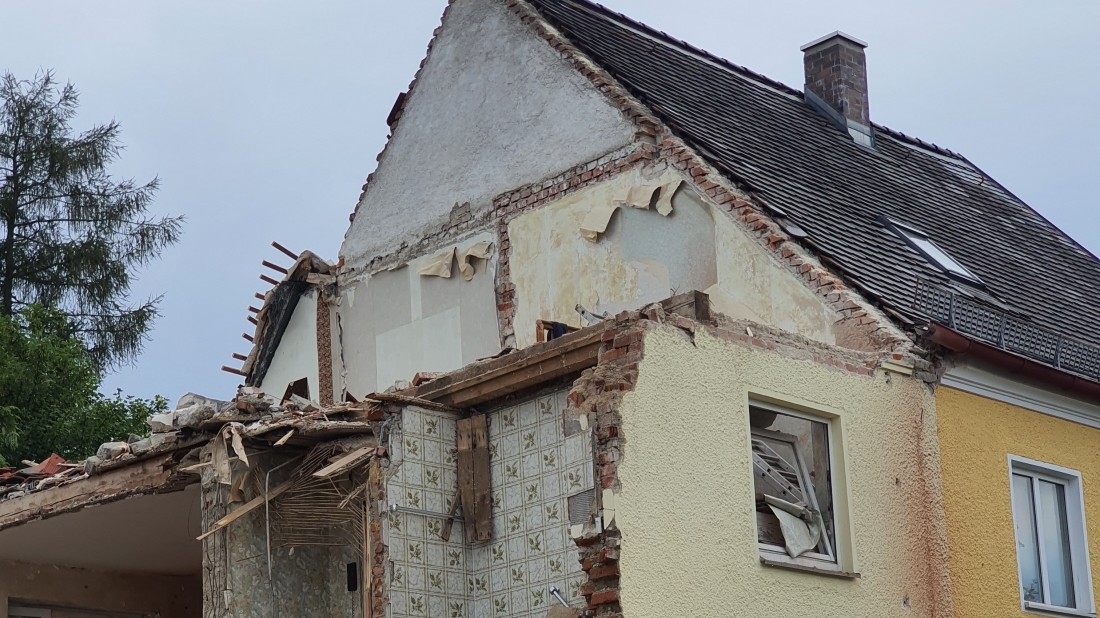Munich-Harlaching: shaking behind the holey wall – Munich
Some legal disputes revolve around incorrectly drawn property lines and their consequences. In the case of the semi-detached house at Bezoldstraße 4 in Harlaching, which was severely damaged when the attached house was demolished, it is about much more than falling fruit, clearing snow or owning a few square meters of real estate. It’s about the livability of a house and the safety of its occupants, as well as how much consideration an owner has to have for the wall of a neighboring house that happens to be on his property.
Almost a year ago, at the end of July 2021, the workers commissioned with the demolition of the southern half had moved too close to the low-lying house, so that the now exposed municipal wall, which was only built as a single shell, became dangerously crooked. The threatening collapse of the wall has now been averted by “needling” it with dozens of metal anchors, although the neighbors are arguing about the costs incurred. In addition, on the evening of February 18, for an unknown reason, the construction crews punched a hole about ten centimeters wide through the wall in the living room, which has not been sealed against the weather since then. It is unclear when the client, a real estate entrepreneur who is known in Harlaching for a large residential and commercial building on Naupliastraße, among other things, will have the damage professionally repaired.
In October 2020, he had bought the southern property, including the vacant semi-detached house, in order to build for himself and his family, as he announced to the SZ in 2021, at the time still willing to name him. In February 2021, the Local Building Commission (LBK) finally approved the application for preliminary approval for a new building. Like a semi-detached house, this would be attached directly to the northern house, but would far exceed its dimensions – both in height, with two full floors plus a converted roof, and in width. A solid, windowless wall would optically seal off and shade the neighboring property. Neighbors Margit and Wilhelm Schefels are suing against the positive LBK decision. They had previously rejected a purchase offer from the new neighbor, and later their offer to provide alternative quarters during the construction period. Moving, says Margit Schefels, is out of the question for her and her husband, aged 77 and 84, respectively, for personal and health reasons.
The damage is obvious.
(Photo: Stephan Rumpf)
The neighbor dismisses the demolition damage from July 2021 as a breakdown, as it could happen. In any case, at this point, probably each of the clear events was how fragile the house halves had been built together in the late 1930s. It was also only afterwards that it turned out that the community wall was beyond the property line, either due to inaccurate measurements or because the northern semi-detached house, which was built a little later, was built with only three walls, although the two-time building permit that came with it had already stipulated a shell wall. According to their lawyer Florian Wehner, the Schefels might have bought a house that was built against the plan and according to the principle of trust and did not have to reckon with the fact that part of it was on neighboring property. Wehner also doubts that the entire wall really belongs to the neighbors. In his opinion, subsequent reinforcements in the roof area protrude back over the property line, which would ultimately make the wall community property. Theoretically, a criminal complaint would also be possible. In terms of a pragmatic solution, however, Attorney Wehner will refrain from doing so for the time being.
The client, himself a structural engineer, considers demolition statics for such small buildings to be unnecessary, at least in retrospect. From his point of view, securing the wall is not a liability case, after all the wall belongs to him – but a concession, which he has now charged the Schefels couple with an amount of 96,000 euros including additional costs per lawsuit. Referring to the property line, he also prohibited the Schefels via a lawyer on March 30 from “carrying out any measures on our client’s property,” i.e. closing the hole that appeared in February – despite the threat of uninhabitability in autumn and winter. Margit Schefels no longer rules out the possibility that the neighbors will try to make her house uninhabitable and thus force her to move out. In any case, at a random meeting on the street at the end of January, he threatened to simply tear down the wall and declare that after initial consideration, the conflict was now “Pandora’s box”.
The administrative court sees the requirement of consideration violated
In terms of building law, the Administrative Court in Munich has meanwhile ruled in favor of the Schefels: A decision dated April 5 suspended the building permit for the time being and held out the prospect of a corresponding verdict, since the project violated several “neighbour-protecting regulations”. Above all, it violates the strict rule of consideration for semi-detached houses. According to the text of the decision, the freedom to build is “simultaneously expanded and restricted” by dispensing with boundary distances. If you add directly to the neighboring house, you gain living space, but you have to keep to the “framework previously drawn through the semi-detached house”, otherwise “the semi-detached character is lost”. Instead of a “harmonious overall body”, however, a building was designed here that degraded the neighboring building to an appendage, as the court explained on the basis of numerous details. The client, on the other hand, states in writing that in a “preliminary assessment” the court only expressed “concerns” about a valid building permit. This was addressed with an adapted building application. Apparently, little should change in the dimensions: “We have decided on a contemporary house that corresponds to the year 2022, this alone requires the current acquisition and production costs of a property,” is the reasoning.
In the meantime, the Schefels have already had a cold winter because of the hole in the wall, cannot use a guest room on the upper floor and fear that the wall, which is cracked on the inside and unprotected on the outside, will be further damaged with every downpour. “For more than a year,” says Margit Schefels, “we have been constantly harassed by this investor who doesn’t want to admit that he miscalculated.”




